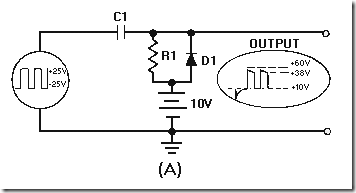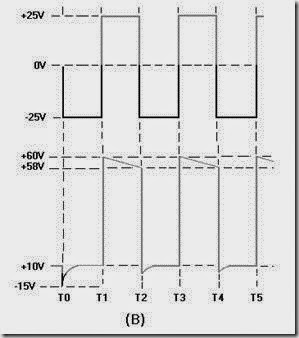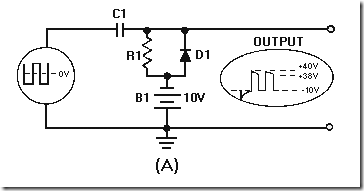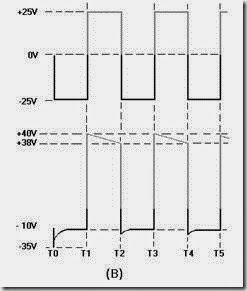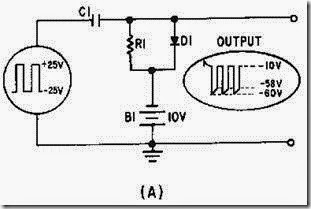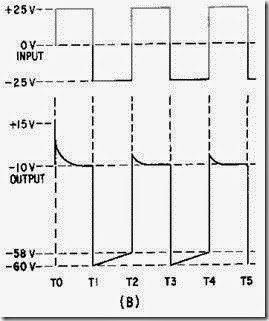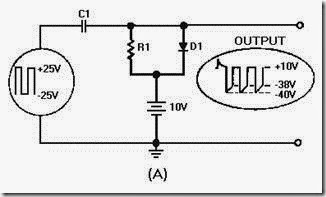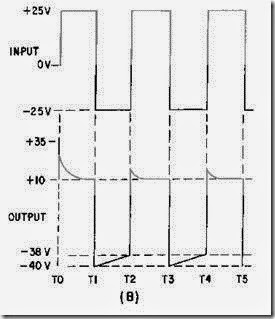DUAL-DIODE LIMITER
The last type of limiter to be discussed in this chapter is the DUAL-DIODE LIMITER, shown in figure 4-15, view (A). This limiter combines a parallel-negative limiter with negative bias (D1 and B1) and a parallel-positive limiter with positive bias (D2 and B2). Parts of both the positive and negative alternations are removed in this circuit. Each battery aids the reverse bias of the diode in its circuit; the circuit has no current flow with no input signal. When the input signal is below the value of the biasing batteries, both D1 and D2 are reverse biased. With D1 and D2 reverse biased, the output follows the input. When the input signal becomes more positive than +20 volts (view (B)), D2 conducts and limits the output to +20 volts. When the input signal becomes more negative than -20 volts, D1 conducts and limits the output to this, value. When neither diode conducts, the output follows the input waveform.
Figure 4-15A.—Dual-diode limiter.
Figure 4-15B.—Dual-diode limiter.
CLAMPERS
Certain applications in electronics require that the upper or lower extremity of a wave be fixed at a specific value. In such applications, a CLAMPING (or CLAMPER) circuit is used. A clamping circuit clamps or restrains either the upper or lower extremity of a waveform to a fixed dc potential. This circuit is also known as a DIRECT-CURRENT RESTORER or a BASE-LINE STABILIZER. Such circuits are used in test equipment, radar systems, electronic countermeasure systems, and sonar systems. Depending upon the equipment, you could find negative or positive clampers with or without bias. Figure 4-16, views (A) through (E), illustrates some examples of waveforms created by clampers. However, before we discuss clampers, we will review some relevant points about series RC circuits.
Figure 4-16A.—Clamping waveforms. WITHOUT CLAMPING.
Figure 4-16B.—Clamping waveforms. WITH CLAMPING, LOWER EXTREMITY OF WAVE IS HELD AT 0V.
Figure 4-16C.—Clamping waveforms. WITH CLAMPING, LOWER EXTREMITY OF WAVE IS HELD AT
+100 V.
Figure 4-16D.—Clamping waveforms. WITH CLAMPING, UPPER EXTREMITY OF WAVE IS HELD AT 0V.
Figure 4-16E.—Clamping waveforms. WITH CLAMPING, UPPER EXTREMITY OF WAVE IS HELD AT–100 V.
SERIES RC CIRCUITS
Series RC circuits are widely used for coupling signals from one stage to another. If the time constant of the coupling circuit is comparatively long, the shape of the output waveform will be almost identical to that of the input. However, the output dc reference level may be different from that of the input. Figure 4-17, view (A), shows a typical RC coupling circuit in which the output reference level has been changed to 0 volts. In this circuit, the values of R1 and C1 are chosen so that the capacitor will charge (during T0 to T1) to 20 percent of the applied voltage, as shown in view (B). With this in mind, let’s consider the operation of the circuit.
Figure 4-17A.—RC coupling.
Figure 4-17B.—RC coupling.
At T0 the input voltage is -50 volts and the capacitor begins charging. At the first instant the voltage across C is 0 and the voltage across R is -50 volts. As C charges, its voltage increases. The voltage across R, which is the output voltage, begins to drop as the voltage across C increases. At T1 the capacitor has charged to 20 percent of the -50 volts input, or -10 volts. Because the input voltage is now 0 volts, the capacitor must discharge. It discharges through the low impedance of the signal source and through R, developing +10 volts across R at the first instant. C discharges 20 percent of the original 10-volt charge from T1 to T2. Thus, C discharges to +8 volts and the output voltage also drops to 8 volts.
At T2 the input signal becomes -50 volts again. This -50 volts is in series opposition to the 8-volt charge on the capacitor. Thus, the voltage across R totals -42 volts (-50 plus +8 volts). Notice that this value of voltage (-42 volts) is smaller in amplitude than the amplitude of the output voltage which occurred at TO (-50 volts). Capacitor C now charges from +8 to +16 volts. If we were to continue to follow the operation of the circuit, we would find that the output wave shape would become exactly distributed around the 0-volt reference point. At that time the circuit operation would have reached a stable operating point. Note that the output wave shape has the same amplitude and approximately the same shape as the input wave shape, but now "rides" equally above and below 0 volts. Clampers use this RC time so that the input and output waveforms will be almost identical, as shown from T11 to T12.
POSITIVE-DIODE CLAMPERS
Figure 4-18, view (A), illustrates the circuit of a positive-diode clamper. Resistor R1 provides a discharge path for C1. This resistance is large in value so that the discharge time of C1 will be long compared to the input pulse width. The diode provides a fast charge path for C1. After C1 becomes charged it acts as a voltage source. The input wave shape shown in view (B) is a square wave and varies between +25 volts and -25 volts. Compare each portion of the input wave shape with the corresponding output wave shape. Keep Kirchhoff’s law in mind: The algebraic sum of the voltage drops around a closed loop is 0 at any instant.
Figure 4-18A.—Positive damper and waveform.
Figure 4-18B.—Positive damper and waveform.
At T0 the -25 volt input signal appears across R1 and D1 (the capacitor is a short at the first instant). The initial voltage across R1 and D1 causes a voltage spike in the output. Because the charge time of C1 through D1 is almost instantaneous, the duration of the pulse is so short that it has only a negligible effect on the output. The -25 volts across D1 makes the cathode negative with respect to the anode and the diode conducts heavily. C1 quickly charges through the small resistance of D1. As the voltage across C1 increases, the output voltage decreases at the same rate. The voltage across C1 reaches -25 volts and the output is at 0 volts.
At T1 the +25 volts already across the capacitor and the +25 volts from the input signal are in series and aid each other (SERIES AIDING). Thus, +50 volts appears across R1 and D1. At this time, the cathode of D1 is positive with respect to the anode, and the diode does not conduct. From T1 to T2, C1 discharges to approximately +23 volts (because of the large values of R and C) and the output voltage drops from +50 volts to +48 volts.
At T2 the input signal changes from +25 volts to -25 volts. The input is now SERIES OPPOSING with the +23 volts across C1. This leaves an output voltage of -2 volts (-25 plus +23 volts). The cathode of D1 is negative with respect to the anode and D1 conducts. From T2 to T3, C1 quickly charges through D1 from +23 volts to +25 volts; the output voltage changes from -2 volts to 0 volts.
At T3 the input signal and capacitor voltage are again series aiding. Thus, the output voltage felt across R1 and D1 is again +50 volts. During T3 and T4, C1 discharges 2 volts through R1. Notice that circuit operation from T3 to T4 is the same as it was from T1 to T2. The circuit operation for each square- wave cycle repeats the operation which occurred from T2 to T4.
Compare the input wave shape of figure 4-18, view (B), with the output wave shape. Note the following important points: (1) The peak-to-peak amplitude of the input wave shape has not been changed by the clamper circuit; (2) the shape of the output wave shape has not been significantly changed from that of the input by the action of the clamper circuit; and (3) the output wave shape is now all above 0 volts whereas the input wave shape is both above and below 0 volts. Thus, the lower part of the input wave shape has been clamped to a dc potential of 0 volts in the output. This circuit is referred to as a positive clamper since all of the output wave shape is above 0 volts and the bottom is clamped at 0 volts.
The positive clamper circuit is self-adjusting. This means that the bottom of the output waveform remains clamped at 0 volts during changes in input signal amplitude. Also, the output wave shape retains the form and peak-to-peak amplitude (50 volts in this case) of the input wave shape. When the input amplitude becomes greater, the charge of the capacitor becomes greater and the output amplitude becomes larger. When the input amplitude decreases, the capacitor does not charge as high as before and clamping occurs at a lower output voltage. The capacitor charge, therefore, changes with signal strength.
The size of R1 and C1 has a direct effect upon the operation of the clamper. Because of the small resistance of the diode, the capacitor charge time is short. If either R1 or C1 is made smaller, the capacitor discharges faster (TC = R · C).
The ability of a smaller value capacitor to quickly discharge to a lower voltage is an advantage when the amplitude of the input wave shape is suddenly reduced. However, for normal clamper operation, quick discharge time is a disadvantage. This is because one objective of clamping is to keep the output wave shape the same as the input wave shape. If the small capacitor allows a relatively large amount of the voltage to discharge with each cycle, then distortion occurs in the output wave shape. A larger portion of the wave shape then appears on the wrong side of the reference line.
Increasing the value of the resistor increases the discharge time (again, TC = R · C). This increased value causes the capacitor to discharge more slowly and produces an output wave shape which is a better reproduction of the input wave shape. A disadvantage of increasing the resistance value is that the larger resistance increases the discharge time of the capacitor and slows the self-adjustment rate of the circuit, particularly in case a sudden decrease in input amplitude should occur. The larger resistance has no effect on self-adjustment with a sudden rise in input amplitude. This is because the capacitor charges through the small resistance of the conducting diode.
Circuits often incorporate a compromise between a short RC time constant (for self-adjustment purposes) and a long RC time constant for less distortion. A point to observe is that the reverse resistance of the diode sometimes replaces the, physical resistor in the discharge path of the capacitor.
Positive-Diode Clamper With Bias
Biased clamping circuits operate in exactly the same manner as unbiased clampers, with one exception. That exception is the addition of a dc bias voltage in series with the diode and resistor. The size and polarity of this bias voltage determines the output clamping reference.
View (A) of figure 4-19 illustrates the circuit of a positive clamper with positive bias. It can be identified as a positive clamper because the cathode of the diode is connected to the capacitor. Positive bias can be observed by noting that the negative side of the battery is connected to ground. The purposes and actions of the capacitor, resistor, and diode are the same as in the unbiased clamper circuit just discussed.
Figure 4-19A.—Positive clamper with positive bias.
Figure 4-19B.—Positive clamper with positive bias.
With no input, D1 is forward biased and the +10 V battery is the output. C1 will charge to +10 V and hold this charge until the first pulse is applied. The battery establishes the dc reference level at +10 volts. The input wave shape at the top of view (B) is a square wave which alternates between +25 and -25 volts. The output wave shape is shown at the bottom half of view (B).
Here, as with previous circuits, let’s apply Kirchhoff’s voltage law to determine circuit operation. With no input signal, the output is just the +10 volts supplied by the battery.
At time T0 the -25 volt signal applied to the circuit is instantly felt across R1 and D1. The -25 volt input signal forward biases D1, and C1 quickly charges to 35 volts. This leaves +10 volts across the output terminals for much of the period from T0 to T1. The polarity of the charged capacitor is, from the left to the right, minus to plus.
At T1 the 35 volts across the capacitor is series aiding with the +25 volt input signal. At this point (T1) the output voltage becomes +60 volts; the voltage across R1 and D1 is +50 volts, and the battery is
+10 volts. The cathode of D1 is positive with respect to the anode and the diode does not conduct. From T1 to T2, C1 discharges only slightly through the large resistance of R1. Assume that, because of the size of R1 and C1, the capacitor discharges just 2 volts (from +35 volts to +33 volts) during this period. Thus,
the output voltage drops from +60 volts to +58 volts.
At T2 the -25 volt input signal and the +33 volts across C1 are series opposing. This makes the voltage across the output terminals +8 volts. The cathode of the diode is 2 volts negative with respect to its anode and D1 conducts. Again, since the forward-biased diode is essentially a short, C1 quickly charges from +33 volts to +35 volts. During most of the time from T2 to T3, then, we find the output voltage is +10 volts.
At T3 the +25 volts of the input signal is series aiding with the +35 volts across C1. Again the output voltage is +60 volts. Observe that at T3 the conditions in the circuit are the same as they were at T1. Therefore, the circuit operation from T3 to T4 is the same as it was from T1 to T2. Circuit operation continues as a duplication of the operations which occurred from T1 to T3.
By comparing the input and output wave shapes, you should note the following: (1) The peak-to- peak amplitude of the input wave shape has not been changed in the output (for all practical purposes) by the action of the clamper circuit; (2) the shape of the input wave has not been changed; (3) the output wave shape is now clamped above +10 volts. Remember that this clamping level (+10 volts) is determined by the bias battery.
Positive-Diode Clamper With Negative Bias
View (A) of figure 4-20 is a positive clamper with negative bias. Observe that with no input signal, the capacitor charges through R1 to the bias battery voltage; the output voltage equals -10 volts. The circuit has negative bias because the positive side of the battery is grounded. The output waveform is shown in view (B). Study the figure and waveforms carefully and note the following important points. Once again the peak-to-peak amplitude and shape of the output wave are, for all practical purposes, the same as the input wave. The lower extremity of the output wave is clamped to -10 volts, the value of the battery. Let’s look at the circuit operation. The capacitor is initially charged to -10 volts with no input signal, and diode D1 does not conduct.
Figure 4-20A.—Positive clamper with negative bias.
Figure 4-20B.—Positive clamper with negative bias.
The -25 volt input signal provides forward bias for D1. The capacitor charges to +15 volts and retains most of its charge because its discharge through R1 is negligible. The +25 volt input signal is series aiding the capacitor voltage and develops +40 volts between the output terminals. When the input voltage is -25 volts, D1 conducts and the output voltage is -10 volts (-25 volts plus +15 volts). In this way the output reference is clamped at -10 volts. Changing the size of the battery changes the clamping reference level to the new voltage.
NEGATIVE-DIODE CLAMPERS
Figure 4-21, view (A), illustrates the circuit of a negative-diode clamper. Compare this with the positive-diode clamper in view (A) of figure 4-18. Note that the diode is reversed with reference to ground. Like the positive clamper, resistor R1 provides a discharge path for C1; the resistance must be a large value for C1 to have a long discharge time. The low resistance of the diode provides a fast charge path for C1. Once C1 becomes charged, it acts as a source of voltage which will help determine the maximum and minimum voltage levels of the output wave shape. The input wave shape shown in view
(B) is a square wave which varies between +25 and -25 volts. The output wave shapes are shown in the bottom half of view (B). You will find that the operation of the negative clamper is similar to that of the positive clamper, except for the reversal of polarities.
Figure 4-21A.—Negative clamper and waveform.
Figure 4-21B.—Negative clamper and waveform.
At T0 the +25 volt input signal applied to the circuit appears across R1 and D1. This makes the anode of D1 positive with respect to the cathode and it conducts heavily. Diode resistance is very small causing C1 to charge quickly. As the voltage across C1 increases, the output voltage decreases. The voltage across C1 reaches 25 volts quickly; during most of T0 to T1, the output voltage is 0.
At T1 the voltage across the capacitor and the input voltage are series aiding and result in -50 volts appearing at the output. At this time the diode is reverse biased and does not conduct. Because of the size of R and C, the capacitor discharges only 2 volts to approximately 23 volts from T1 to T2. Using Kirchhoff’s voltage law to determine voltage in the circuit, we find that the output voltage decreases from -50 to -48 volts.
At T2 the +25 volt input signal and the 23 volts across C1 are series opposing. The output voltage is +2 volts. The anode of D1 is positive with respect to the cathode and D1 will conduct. From T2 to T3, C1 charges quickly from 23 to 25 volts through D1. At the same time, the output voltage falls from +2 to 0 volts.
At T3 the input and capacitor voltages are series aiding and the total output voltage is -50 volts. From T3 to T4, D1 is reverse biased and C discharges through R. The circuit operation is now the same as it was from T1 to T2. The circuit operation for the following square-wave cycles duplicates the operation which occurred from T1 to T3.
As was the case with the positive clamper, the amplitude and wave, shape of the output is almost identical to that of the input. However, note that the upper extremity of the output wave shape is clamped to 0 volts; that is, the output wave shape, for all practical purposes, lies entirely below the 0-volt reference level.
Negative-Diode Clamper With Negative Bias
View (A) of figure 4-22 is the circuit of a negative clamper with negative bias. Again, with no input signal the capacitor charges to the battery voltage and the output is negative because the positive side of the battery is ground. The bottom of view (B) shows the output of the circuit. Study the figure carefully, and note the following important points. The peak-to-peak amplitude and shape of the output wave, for all practical purposes, are the same as that of the input wave. The output wave is clamped to -10 volts which is the value of the battery. Since this is a negative clamper, the upper extremity of the waveform touches the -10 volt reference line (and the rest of it lies below this voltage level).
Figure 4-22A.—Negative damper with negative bias.
Figure 4-22B.—Negative damper w ith negative bias.
Let’s review the important points of circuit operation. The capacitor is initially charged to -10 volts with no input signal. Applying Kirchhoff’s law we find that the +25 volt input signal and the 10-volt battery are series opposing. This series opposing forward biases D1 and the capacitor charges to -35 volts. The output voltage is equal to the sum of the capacitor voltage and the input voltage. Thus, the output voltage is -10 volts and the wave shape is clamped to -10 volts. With a -25 volt input, the charge maintained across C1 and the input are series aiding and provide a -60 volt output. C1 will discharge just before the next cycle begins and the input becomes positive. The +25 volt input signal and the approximately -23 volt charge remaining on C1 will forward bias D1 and the output will be clamped to the battery voltage. C1 will quickly charge to the input signal level. Thus, the output voltage varies between -10 and -60 volts and the wave shape is clamped to -10 volts.
Negative Clamper With Positive Bias
View (A) of figure 4-23 illustrates the circuit of a negative clamper with positive bias. With no input signal the capacitor charges to the battery voltage and the output is positive because the negative side of the battery is grounded. The output is illustrated in the bottom half of view (B). Study the figure carefully and note the following important points. The peak-to-peak amplitude and shape of the output waveform, for all practical purposes, are the same as that of the input. The output wave is clamped to +10 volts, the value of the battery. Since this is a negative clamper (cathode to ground), the top of the output wave touches the +10 volt reference line.
Figure 4-23A.—Negative clamper with positive bias.
Figure 4-23B.—Negative clamper with positive bias.
Let’s go over a summary of the circuit operation. With no input signal the capacitor charges to 10 volts. The +25 volt input signal forward biases D1. With the 10-volt battery and the input in series, the capacitor charges to -15 volts. The capacitor remains charged, for all practical purposes, since its discharge through R1 (very large) is almost negligible. The output voltage is equal to the algebraic sum of the capacitor voltage and the input voltage. The +25 volt input signal added to the -15 volt capacitor charge provides a +10 volt output. With a -25 volt input at T1, D1 is reverse-biased and the charge across C 1 adds to the input voltage to provide a -40 volt output. From T1 to T2, the capacitor loses only a small portion of its charge. At T2 the input signal is +25 volts and the input returns to +10 volts. The wave shape is negatively clamped to +10 volts by the battery.
We can say, then, that positive clamping sets the wave shape above (negative peak on) the reference level, and negative clamping places the wave shape below (positive peak on) the reference level.
Q6. What is the relative length of the time constant for the diode-capacitor combination in a damper (long or short)?
Q7. What is the relative length of the discharge time constant with respect to the charge time constant of a damper (long or short)?
Q8. A positive damper clamps which extremity of the output signal to 0 volts?
Q9. To which polarity does a positive damper with positive bins clamp the most negative extremity of the output waveform (positive or negative)?
Q10. What type damper (with bias) clamps the most negative extremity of the output waveform to a negative potential?
Q11. A negative damper damps which extremity of the output waveshape to 0 volts?
Q12. A negative damper with negative bias clamps the most positive extremity of the output wave shape to what polarity (positive or negative)?
Q13. What type of bias (positive or negative) is added to a negative damper for the most positive extremity of the wave shape to be clamped above 0 volts?
Q14. What would be the output of a negative clamper with a bias potential of –5 volts and an input voltage swing from +50 to –50 volts?












